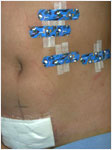Laparoscopic Donor Nephrectomy
For over a decade, UCSF transplant surgeons have performed a minimally invasive procedure known as a laparoscopic donor nephrectomy. A nephrectomy is the removal of a kidney.
In a laparoscopic donor nephrectomy, a kidney is transplanted from a living donor to a recipient, the patient. Traditionally, a live donor nephrectomy required a healthy individual, the donor, to undergo a major operation where the kidney was removed through an incision in the side using a large incision. This so-called "open" procedure was associated with significant pain and a substantial recuperation period for the donor.

In contrast, in a laparoscopic donor nephrectomy, tiny incisions are used and the kidney is removed using a scope or camera and special miniaturized surgical instruments. The procedure is, similar to one used to remove a gall bladder. This minimally invasive procedure has a shorter recovery period and the complication rate is very low. In addition, the quality and function of the transplanted kidneys are excellent.
In the procedure, the kidney is freed using 4 ports and removed through an incision in the lower abdomen.The transplant surgeon is waiting and immediately prepares the kidney and places it in the recipient. Results (graft survival) have been comparable to kidneys removed via traditional open surgery. In addition, patients are hospitalized approximately 3 days shorter and return to normal activity almost 3 weeks earlier.
Finally, when a patient receives a kidney from a living donor, as compared with a cadaver kidney from a deceased person, there are a number of distinct advantages including:
- decreased waiting time
- lower incidence of delayed graft function
- improved patient and graft survival
- increased cost effectiveness
UCSF has performed more than 850 of laparoscopic donor nephrectomies in its kidney transplant program making it one of the largest and most experienced program in the U.S.






